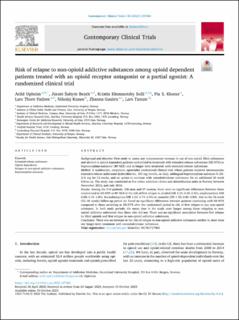| dc.contributor.author | Opheim, Arild | |
| dc.contributor.author | Saltyte Benth, Jurate | |
| dc.contributor.author | Solli, Kristin Klemmetsby | |
| dc.contributor.author | Kloster, Pia Synnøve | |
| dc.contributor.author | Fadnes, Lars T. | |
| dc.contributor.author | Kunøe, Nikolaj | |
| dc.contributor.author | Gaulen, Zhanna | |
| dc.contributor.author | Tanum, Lars Håkon Reiestad | |
| dc.date.accessioned | 2024-01-04T12:28:56Z | |
| dc.date.available | 2024-01-04T12:28:56Z | |
| dc.date.created | 2023-10-24T11:58:12Z | |
| dc.date.issued | 2023 | |
| dc.identifier.issn | 1551-7144 | |
| dc.identifier.uri | https://hdl.handle.net/11250/3109844 | |
| dc.description.abstract | ackground and objective: First study to assess any compensatory increase in use of non-opioid illicit substances
and alcohol in opioid dependent patients randomized to treatment with extended-release naltrexone (XR-NTX) or
buprenorphine-naloxone (BP-NLX) and in longer term treatment with extended-release naltrexone.
Method: A multicenter, outpatient, open-label randomized clinical trial where patients received intramuscular
extended-release naltrexone hydrochloride, 380 mg/month, or daily sublingual buprenorphine-naloxone 8–24/
2–6 mg for 12 weeks, and an option to continue with extended-release naltrexone for an additional 36 week
follow-up. The study was conducted at five urban addiction clinics and detoxification units in Norway between
November 2012, and July 2016.
Results: Among the 143 patients, 106 men and 37 women, there were no significant differences between those
randomized to XR-NTX or BP-NLX in the risk of first relapse to alcohol (HR 1.31; 0.68–2.53), amphetamines (HR
0.88; 0.43–1.80), benzodiazepines (HR 1.24; 0.74–2.09) or cannabis (HR 1.55; 0.83–2.89). Also in the 36-week
(12–48 weeks) follow-up period we found no significant differences between patients continuing with XR-NTX
compared to those switching to XR-NTX after the randomized period in risk of first relapse to any non-opioid
substance. In both study periods, the mean time in the study were longer among those relapsing to non-
opioid addictive substances than those who did not. There was no significant association between first relapse
to illicit opioids and first relapse to non-opioid addictive substances.
Conclusion: There was no increase in the risk of relapse to non-opioid addictive substances neither in short term
nor longer-term treatment with extended-release naltrexone. | en_US |
| dc.language.iso | eng | en_US |
| dc.rights | Navngivelse 4.0 Internasjonal | * |
| dc.rights.uri | http://creativecommons.org/licenses/by/4.0/deed.no | * |
| dc.title | Risk of relapse to non-opioid addictive substances among opioid dependent patients treated with an opioid receptor antagonist or a partial agonist: A randomized clinical trial | en_US |
| dc.type | Peer reviewed | en_US |
| dc.type | Journal article | en_US |
| dc.description.version | publishedVersion | en_US |
| cristin.ispublished | true | |
| cristin.fulltext | original | |
| cristin.qualitycode | 1 | |
| dc.identifier.doi | 10.1016/j.cct.2023.107360 | |
| dc.identifier.cristin | 2187937 | |
| dc.source.journal | Contemporary Clinical Trials | en_US |
| dc.source.volume | 135 | en_US |

